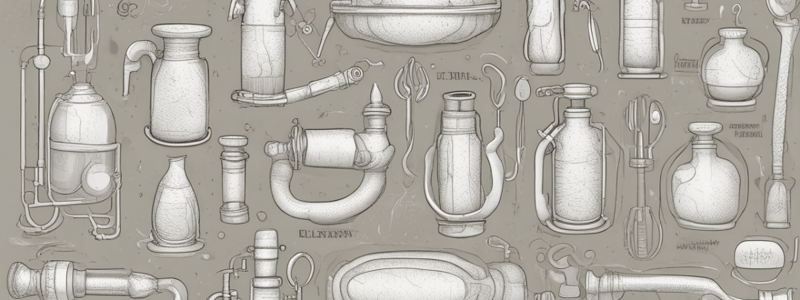Podcast
Questions and Answers
What is the primary function of a hypertonic enema, such as sodium phosphate?
What is the primary function of a hypertonic enema, such as sodium phosphate?
- To pull fluid from the interstitial space into the colon to soften stool (correct)
- To lubricate and soften hard stool mass
- To add fluid into the colon to cause distension
- To irritate the walls of the colon to cause peristalsis
Which type of enema is contraindicated in infants and children?
Which type of enema is contraindicated in infants and children?
- Soapsuds cleansing
- Normal saline cleansing
- Hypertonic sodium phosphate cleansing
- Tap water cleansing (correct)
What is the purpose of a return flow enema?
What is the purpose of a return flow enema?
- To remove flatus from the colon (correct)
- To soften hard stool
- To exchange substances and decrease inflammation
- To distend the colon and increase peristalsis
What is the recommended position for inserting an enema?
What is the recommended position for inserting an enema?
What is a complication of an enema that may occur if the vagus nerve is stimulated?
What is a complication of an enema that may occur if the vagus nerve is stimulated?
What type of enema is used to lubricate and soften hard stool mass?
What type of enema is used to lubricate and soften hard stool mass?
What is the purpose of a medicated enema?
What is the purpose of a medicated enema?
What is a contraindication for administering an enema?
What is a contraindication for administering an enema?
What is the purpose of a digital removal before administering an enema?
What is the purpose of a digital removal before administering an enema?
What type of urostomy is created from a section of small intestine and used to collect urine?
What type of urostomy is created from a section of small intestine and used to collect urine?
Flashcards are hidden until you start studying
Study Notes
Enema Types
- Tap Water Cleansing (Hypotonic): allows fluid to be in the colon with interstitial fluid to distend colon and increase peristalsis, not safe for infants, children, and heart failure patients, don't give more than 3 liters
- Normal Saline Cleansing (Isotonic): adds fluid into colon causing distension and increase peristalsis, safe for children and heart failure patients, dosages vary by age:
- Infants: 50 to 150 mL
- Toddlers: 250 to 350 mL
- School-Age: 300 to 500 mL
- Soapsuds Cleansing: Castile soap added to tap or normal saline, distends the colon and irritating walls of colon to cause peristalsis, mix in saline for infants, children, and patients with heart failure
- Hypertonic Sodium Phosphate Cleansing: pulls fluid from interstitial space into colon to soften stool and increase peristalsis
- Oil Retention: softens hard stool, lubricates and softens hard stool mass, enables easier removal, instill one hour before removing
- Medicated Enema: exchange of substances and decreases inflammation, types include:
- Steroid: decreases inflammation of rectal walls and colon
- Kayexalate: pulls potassium from body tissues and binds with it, excess leaves body when expelled
- Milk and Molasses Cleansing: hypertonic, pulls fluid into colon to soften stool, must be heated together, then cooled to body temperature
Specialized Enema Procedures
- Return Flow/Harris Flush/Siphon Enema: removes flatus, uses tap water or saline with 100 to 200 mL of solution, raises and lowers enema to siphon out flatus, repeat until no bubbles
- High Enema: cleanses higher colon, beyond sigmoid, distends colon and moves into descending and transverse colon, begins with patient in left semi-prone position, uses half of the fluid, then turns to back and right side to finish enema
Precautions and Contraindications
- Contraindications:
- Rectal surgery
- Severe bleeding hemorrhoids
- Ulcerative colitis/Crohn's disease
- Rectal fissure or cancer
- Excessive bleeding potential from disease or medication
- Heart conditions; myocardial infarction or unstable angina
- Associated Problems:
- Stimulation of Vagus Nerve Symptoms: chest pain or heaviness/pressure, shortness of breath or inability to breathe, dizziness, feeling faint, nausea, pallor, clammy skin, pulse below 60 bpm
- Causing constriction of bronchioles in lungs, unable to support adequate blood pressure and circulation
- Perforating the Colon: may introduce bacteria into peritoneal cavity, bleeding, or hemorrhage to occur, don't force when meeting resistance
Ostomies
- Urinary:
- Ileal Conduit: ureters attached to section of small intestine, used as a small pouch and stoma where patient wears an appliance over stoma to collect urine, redness can occur which would require the use of barrier ointment to protect skin
- Continent Urostomy/Indiana Pouch: pouch created from large and small intestines, ureters diverted into the pouch with an opening constructed for a catheter to be inserted
- Neobladder/Orthotopic: substitute bladder created from large or small intestine, ureters diverted into it and connected to the urethra
Studying That Suits You
Use AI to generate personalized quizzes and flashcards to suit your learning preferences.




